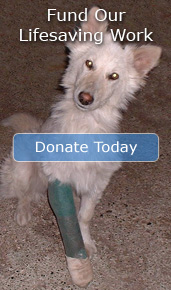Puppymill Investigations
AAS investigations and reports into out-of-control dog breeding in BC
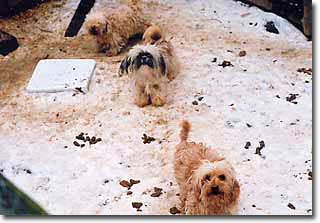
Puppymills and backyard breeders in BC - fifty years of shame!
- What are puppymills and backyard breeders?
- What should be done? AAS's control of breeding proposal, "Too Many Dogs"
- Investigations in the North Okanagan
- Scroll down to see which breeders have been busted!
Puppymill investigations
Animal Advocates Society has been contacted about and has investigated many puppymills in BC. AAS learns of these puppymills when it is contacted by purchasers of sick or genetically malformed pups; by potential puppy purchasers who have been horrified by what they have seen; and by neighbours of the puppymills.
In almost every case the complainant has first asked the BC SPCA to "do something" and has been told by the SPCA that there is nothing the SPCA can do.
The existence of some of these puppymills and the glaringly inhumane conditions have been known to the SPCA for many years, sometimes for many decades.
We believe that there are a hundred or more puppymills in BC and we believe that the BC SPCA has been told of most, if not all of them.
The BC SPCA did take action against one notorious puppymiller, Marcie Ryan of Agassiz BC, but not until she had been in business for many years and not until Global TV did a story on her. So it seems that the BC SPCA can do something if there is enough publicity.
AAS has seen puppymill dogs kept in muddy outdoor pens, in barns, garages, sheds, and trailers, in tiny, rusty cages.
We have seen puppies with stomachs bloated with parasites, weeping eyes, and feces-matted fur, living in filth, with nowhere to exercise properly, and with no water.
And the stench cannot be described.
Animal Advocates Society has systematically investigated some of the puppymills in the North Okanagan. All these mills have been reported to the SPCA, some for decades.
The pups from these puppymills are mostly sold to private puppy resellers who run their businesses out of their homes (unlicensed in any way), and pet stores in the Lower Mainland. The puppy resellers that AAS is aware of have also been reported to the SPCA.
After fifty years of complaints about puppymills, the BC SPCA still has no policy regarding them, nor to our knowledge has it ever asked for regulatory legislation. And yet they are the only authority that the province and municipal governments acknowledge. They have the power to make the changes.
Keep in mind as you're reading the report on the first puppymill that the SPCA admits that it knows this puppymill has existed since 1956.
Puppymill # 1 - the "R's" in the North Okanagan
Dec. 12, 2000, I (AAS investigator) was met by a Shar pei cross (the 'guard dog") outside the R's run- down home. She was obviously either pregnant or nursing (I later found out that it wouldn't have been nursing - two different sources told me that she kills and eats her puppies as they are born. This I feel is to save them from the horror that she endures living there). She lives outside with her short Shar-pei hair - it was regularly anywhere from -10 to -24 degrees Celsius out there this winter. On that day she had a frying pan with frozen scrambled eggs to eat. When I came back 4 days later, the same pan of frozen eggs was there, untouched.
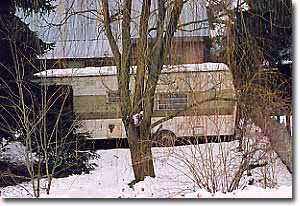 The Salmon Arm SPCA states that this mill has been in operation since 1956, that it knows of. Neighbours who have been on the property report that the R's have had as many as 75 dogs. A personal acquaintance of the R's who visited the premises in November 2000, said the R's told her at that time they had 64 dogs and 18 puppies. R told me herself that the SPCA has been on her property many times, every year, gone through the whole place, and never found anything wrong. According to R, she's never even been issued a warning. (This may not be true.)
The Salmon Arm SPCA states that this mill has been in operation since 1956, that it knows of. Neighbours who have been on the property report that the R's have had as many as 75 dogs. A personal acquaintance of the R's who visited the premises in November 2000, said the R's told her at that time they had 64 dogs and 18 puppies. R told me herself that the SPCA has been on her property many times, every year, gone through the whole place, and never found anything wrong. According to R, she's never even been issued a warning. (This may not be true.)

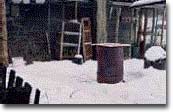
Read all about it on the AAS Animals' NewsRoom board
The R's property is littered with old car parts, rusty farm equipment, and garbage. Inside the house junk and garbage is piled everywhere, right up to and obscuring the windows. The house is quite dark. Buckets of moldy food litter the kitchen floor. The counters are covered in dirty dishes, rotten food, eggshells, etc. Several species of exotic birds, cockatiels, etc. live in cages in the kitchen. There is a tiny old Yorkshire terrier who has earned the "privilege" of being "housedog" because she's had so many litters, thus making the R's a lot of money. She has a severe skin condition and almost no hair. R says he sprays her regularly with Raid to "keep the parasites down".
I was taken outside to a ramshackle wooden shed in which were housed many small dogs in cages. There were two rows of cages with 2-4 dogs in a cage and an aisle down the middle. This is all I could glimpse as R went in and out, slamming the door quickly behind her each time. It was obvious she did not want us to see inside. (She KNOWS what she's doing is horrific). The shed was padlocked, as was the trailer 20 feet away from it, which we were never allowed near, but from which a cacophony of small barking voices could be heard.
R gave us 2 dogs from the shed. The first was a tiny female Chihuahua cross. R handed her to my friend, saying "you may as well take her-her puppies always die." The second dog we were given was a female Yorkshire terrier with a mammary tumour and a mouth full of rotten teeth. She had a CKC tattoo which I traced through the CKC to a breeder in Quebec. The CKC would not give me the name of this breeder; all they would tell me was that they were no longer a member of their organization.
Report on Pomeranian - from Central Animal Hospital, Vernon, BC
Dog is extremely pruritic (intense itching) over entire body. Severe alopecia (hair loss) over the entire body. Skin is heavily pigmented in groin area and behind the ears due to long term irritation. Eyes exhibit periorbital alopecia and slight discharge. Overall stench of infected skin and old urine emanating from this dog's body is quite remarkable. Areas of alopecia and hyperpigmentation include periorbital, caudal aspect of both ears, ventral neck, axillary, flanks, umbilical. Skin scrapings of dorsal pigmented areas reveal large numbers of gram positive bacteria. Severe gingivitis, retained deciduous upper left canine interfering with overall oral health. Fecal exam positive for Ascarids and Cestodes.
Skipper
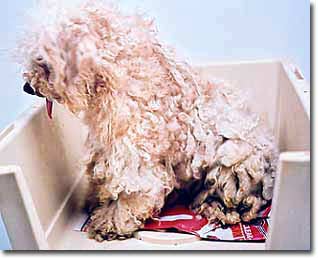 The ground was covered in frozen feces, urine, cedar shavings (dogs are often highly allergic to cedar) and snow. There were feces in his food dish. Temperatures there average -5 to -20 Celsius in the winter. I saw no water and no food in that pen any time I visited. R had to wear heavy gloves to pick Skipper up - the dog had obviously had no socialization and went into a frenzy of screaming, writhing, and biting in self-defense at the sheer terror of being lifted up. When I got him to my place I was unable to touch him for 3 days- he was just absolutely terrified. He was shaved off under sedation at the vet's. His coat was about 4 inches thick of solid matting over his entire body, and smelled of feces and urine. The whole building smelled like he did by the time we were done. He was neutered and treated for a long-term ear infection. He turned into the sweetest, most loving dog, once he discovered humans were okay, and began proper socialization. Within 2 weeks I was able to pick him up, carry him, bathe him, no problem.
The ground was covered in frozen feces, urine, cedar shavings (dogs are often highly allergic to cedar) and snow. There were feces in his food dish. Temperatures there average -5 to -20 Celsius in the winter. I saw no water and no food in that pen any time I visited. R had to wear heavy gloves to pick Skipper up - the dog had obviously had no socialization and went into a frenzy of screaming, writhing, and biting in self-defense at the sheer terror of being lifted up. When I got him to my place I was unable to touch him for 3 days- he was just absolutely terrified. He was shaved off under sedation at the vet's. His coat was about 4 inches thick of solid matting over his entire body, and smelled of feces and urine. The whole building smelled like he did by the time we were done. He was neutered and treated for a long-term ear infection. He turned into the sweetest, most loving dog, once he discovered humans were okay, and began proper socialization. Within 2 weeks I was able to pick him up, carry him, bathe him, no problem.
Vet report on Skipper:
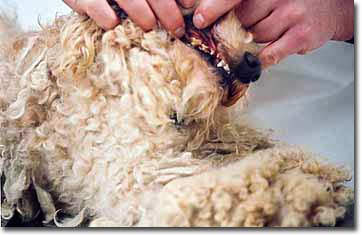 Abnormal findings: attitude extremely withdrawn and fearful. Entire body is covered in matted haircoat at least 3" thick. Haircoat on legs, ventral abdomen, and perianal area significantly soiled with urine and feces resulting in a foul odour. Dental exam revealed severe tartar and gingivitis. Clipping revealed numerous areas of scabby skin and old puncture wounds, most likely bite wounds. Corners of eyes were crusted with layers of dried discharge. Pads of feet were significantly matted. Some matts involving toenails, causing discomfort when walking. Fecal tested positive for Ascarids and Cestodes.
Abnormal findings: attitude extremely withdrawn and fearful. Entire body is covered in matted haircoat at least 3" thick. Haircoat on legs, ventral abdomen, and perianal area significantly soiled with urine and feces resulting in a foul odour. Dental exam revealed severe tartar and gingivitis. Clipping revealed numerous areas of scabby skin and old puncture wounds, most likely bite wounds. Corners of eyes were crusted with layers of dried discharge. Pads of feet were significantly matted. Some matts involving toenails, causing discomfort when walking. Fecal tested positive for Ascarids and Cestodes.
 We saw 7 malti-poos also in outside cages, in subzero temperatures, wall to wall feces, matted coats, no food or water to be seen anywhere. (Even if there had been water, it would be frozen solid.) And according to a neighbour, the Salmon Arm SPCA routinely visits these premises and sees nothing wrong. R told me herself that the SPCA has been on her property many times, every year, gone through the whole place, and never found anything wrong. According to R, she's never even been issued a warning. (This may not be true.)
We saw 7 malti-poos also in outside cages, in subzero temperatures, wall to wall feces, matted coats, no food or water to be seen anywhere. (Even if there had been water, it would be frozen solid.) And according to a neighbour, the Salmon Arm SPCA routinely visits these premises and sees nothing wrong. R told me herself that the SPCA has been on her property many times, every year, gone through the whole place, and never found anything wrong. According to R, she's never even been issued a warning. (This may not be true.)
The 3 dogs I retrieved from the puppymill that day were covered in feces. They were significantly underweight, and were riddled with tapeworm and roundworm.
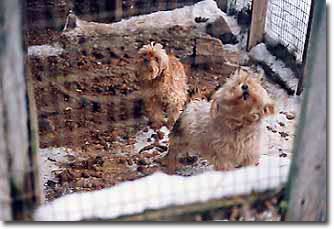 It took 2 months of medication to eradicate their intestinal parasites, they were so infected. The veterinarian who spayed the 2 females reported that the uteruses of both dogs were "definitely VERY used". D has been inside and helped R cut the dogs' hair (with scissors) last summer and was describing maggots etc.
It took 2 months of medication to eradicate their intestinal parasites, they were so infected. The veterinarian who spayed the 2 females reported that the uteruses of both dogs were "definitely VERY used". D has been inside and helped R cut the dogs' hair (with scissors) last summer and was describing maggots etc.
It occurred to me as I waded amidst the filth and stench at R's today just how clean and warm and healthy that barn was where those dogs in Agassiz were kept- the mill that the SPCA finally "raided" after Global TV exposed what the SPCA must have known about for years. From what I saw of the news story video footage those dogs lived in luxury compared to the R's dogs. The Agassiz dogs had a nice barn (shelter) and food and water dishes and no feces in their pens. The R's dogs live in excrement in subzero temperatures with only wooden huts. They have no dishes. Food is thrown to them like chicken scratch on the ground, and I guess they eat snow for hydration. I have no idea what happens in summer. Their existence is far more atrocious than what was shown at the Agassiz puppymill.
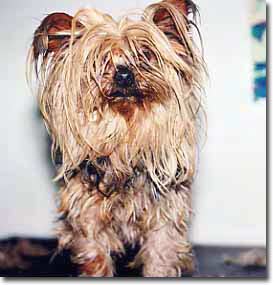 Tulip was handed over because she was not producing puppies. R said she was old. When I first saw her I thought she must be at least 9 or 10, as her teeth were so green and rotten, and I could feel mammary tumours. Turns out she had a CKC tattoo on her flank which put her at 6 years old. I called the CKC but they would only tell me the tattoo traced to a breeder in Quebec who had applied for his membership the year this tattoo was done and had not renewed his membership the following year. No names were given. I informed the CKC rep that this was a dog I had removed from a puppymill in BC but she didn't seem interested in pursuing it.
Tulip was handed over because she was not producing puppies. R said she was old. When I first saw her I thought she must be at least 9 or 10, as her teeth were so green and rotten, and I could feel mammary tumours. Turns out she had a CKC tattoo on her flank which put her at 6 years old. I called the CKC but they would only tell me the tattoo traced to a breeder in Quebec who had applied for his membership the year this tattoo was done and had not renewed his membership the following year. No names were given. I informed the CKC rep that this was a dog I had removed from a puppymill in BC but she didn't seem interested in pursuing it.
R told me that they deal with ____Pet Store in Vernon (have for 12 years now), and The ____ pet shop in Salmon Arm, that I know of for sure. I have heard rumours of pet shops that won't deal with them because the puppies are always unhealthy. The R's have a go-between, A, the CKC registered breeder of Maltese terriers. A takes in litters of R's pups and gets them healthy enough to sell. I know of 2 cross-breed dogs that were purchased from A.
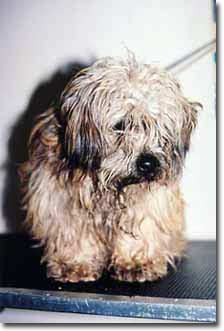 Jasper had been living in subzero temperatures in a tiny 3x3 foot chicken wire pen, most of the space in this pen being taken up by an old rotten doghouse that was too small for him to fit into. He ran in circles around it, in a path of trampled poop. He also had no water, like the others. However, his was the only cage I saw food in. There was a dish in the corner of the cage. In it was dog kibble and feces. R told me that Jasper was kept alone because he fought with the other males. I have been told by neighbours of instances where they witnessed R's turning multiple males all together into a pen with females in heat, and of course, fights ensued. I suspect Jasper won because of size. When Jasper arrived at my place he was clipped down (matted, filthy, stinking of excrement). He never fought with any of my dogs- in fact he delighted in playing with them.
Jasper had been living in subzero temperatures in a tiny 3x3 foot chicken wire pen, most of the space in this pen being taken up by an old rotten doghouse that was too small for him to fit into. He ran in circles around it, in a path of trampled poop. He also had no water, like the others. However, his was the only cage I saw food in. There was a dish in the corner of the cage. In it was dog kibble and feces. R told me that Jasper was kept alone because he fought with the other males. I have been told by neighbours of instances where they witnessed R's turning multiple males all together into a pen with females in heat, and of course, fights ensued. I suspect Jasper won because of size. When Jasper arrived at my place he was clipped down (matted, filthy, stinking of excrement). He never fought with any of my dogs- in fact he delighted in playing with them.
Another investigator's report on the R's puppymill
Not until you see and smell it will you believe it
Everyone has heard about puppymills; many people have watched televised reports about them and have been shocked and dismayed about the living conditions of the dogs incarcerated there. But, until a person has actually been inside a puppy farm, nothing could prepare anyone for the abysmal misery the dogs are subjected to every day of their lives.
We had been told that a puppymill was getting rid of some of their breeding stock. At the R's 'farm', a large, Pit Bull Terrier type dog and a very disgruntled man met us. Even at first glance the place had an oppressive air about it; rotting sheds leaned against each other, and rusting, broken equipment littered the yard.
After initial, not very friendly conversation with one of the owners, we were taken to a boarded off area with two dogs. They looked somewhat like poodles. We could not catch them; every time the man came near them, the mud and dung covered dogs darted out of reach. From there we were taken to the so-called puppy house. Besides the terrible stench, it was not as bad as the first place.
Dogs were in three-foot square pens. We lifted one after the other up, and if we got the go ahead to do so, we placed them into carriers and took them to the truck before the owner could change his mind. There were several dogs left behind. It was heartbreaking to look into their eyes; my friend and I found it difficult to keep our emotions in check.
We were escorted to a dingy, dirty travel trailer that housed a female dog with her litter of about six puppies. These dogs were in a wire cage with only enough space for each to stand up in. The mother dog was sitting in a corner, if she would lie down, the pups would have to bunch up on top of each other. Of course we were not given any of these dogs.
The last stop was another leaning, rotting shed filled with small dogs. There was only room enough for one of us to go in at the time, so it was difficult to see exactly how many dogs were in there. All the animals were wildly jumping up and barking furiously. The stink was unbearable in the small space.
The dogs I was allowed to pick up were in an adjoining pen. We pried open a broken-down gate and I went inside. I caught the two small dogs, but it was a balancing act to remain standing in the accumulated dog feces, and to get out again through the broken gate.
What did we accomplish with our 'arranged' rescue? We did not eliminate the operation of a PuppyMill, but we improved the lives of twelve dogs - those little canines were the objects of our efforts. In order to close Puppy Farms, it will take much more than individual efforts, SPCA involvement or human outrage, it will, in the end, take the political will of a country.
Puppymill #2
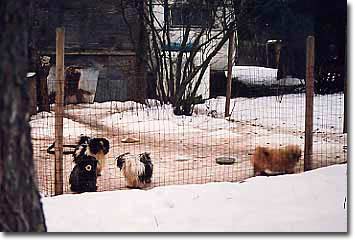 R's next-door neighbour also breeds dogs. R was planning to get some shih tzus from this neighbour the last time we spoke to him, because as R said,"crossing them with his poodles "makes a better mix". The black dog in the lower left corner of this photo has a bone stuck around its jaws.
R's next-door neighbour also breeds dogs. R was planning to get some shih tzus from this neighbour the last time we spoke to him, because as R said,"crossing them with his poodles "makes a better mix". The black dog in the lower left corner of this photo has a bone stuck around its jaws.
Some other puppymills in the Okanagan
I met a girl who'd met B in Merritt, while stopped at a park for lunch. B had a van full of puppies and was taking them to the coast. R told me B is a person she has often bought dogs from, and has 150 dogs in her barn. She is very secretive, doesn't advertise herself or want anyone on her property. She is on Highway 97 between Kamloops and Westwold. I've been told by several different sources that she has over 130 dogs in a barn.
Kamloops SPCA told me they had been inside B's barn several times and found nothing wrong with her operation. At the same time however, Kamloops SPCA also recommended I not purchase a puppy from B as they weren't likely to be very healthy. Kamloops SPCA also reported that it was unlikely I would be able to deal with B directly as she didn't sell privately, and that she only deals with brokers and pet stores. Have not secured any dogs from this facility. One Pomeranian given to me by R had been purchased from B for $375 for breeding purposes.
Today I saw an 8 month old Shih Tzu that was purchased in Kelowna out of a van full of puppies from a woman named L , a breeder in Princeton.
Animal Advocates Society came into the possession of a beagle with its papers, sold by CKC breeder S of Salmon Arm to long-time North Vancouver puppy-reseller, Debra Skippon. CKC breeders are not supposed to sell to resellers.
"The Puppy Patch", advertises itself with a sign at the end of the driveway. It is on Highway 97 between Falkland and Westwold. Read all about it on the AAS Animals' Newsroom Board. (We posted this praise of the SPCA before we realized that it would kill some of the dogs that it had so "heroically rescued".)
Dogs in Canada magazine, at least back as far as 10 years has advertised breeders who have a dozen or more breeds tracing to the same phone numbers. The president of the Kennel Club, has begged the CKC via phone and mail to look into this and give an explanation. She told me they just blame it on their publishers, and refuse to take any interest.
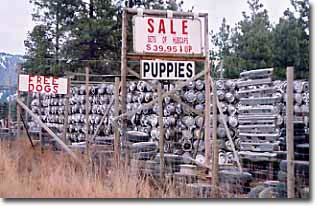 Hub cap breeder
Hub cap breeder
This person is on the highway between Kelowna and Westbank. His kennel that provides the "free dogs" and "puppies" is located in Beaverdell, about 70 miles east of Kelowna.
July 2002 - the Kelowna SPCA finally seized some of these dogs. And then killed most of them over the course of seven months. See Topaz Creek/Beaverdell Dogs: a Comparison and Outcome.
Read the touching story of Beegee, the blind, worn out breeder left in the woods to die when she was no longer profitable, as told by Diane Nicholson, the woman who found her and saved her.



